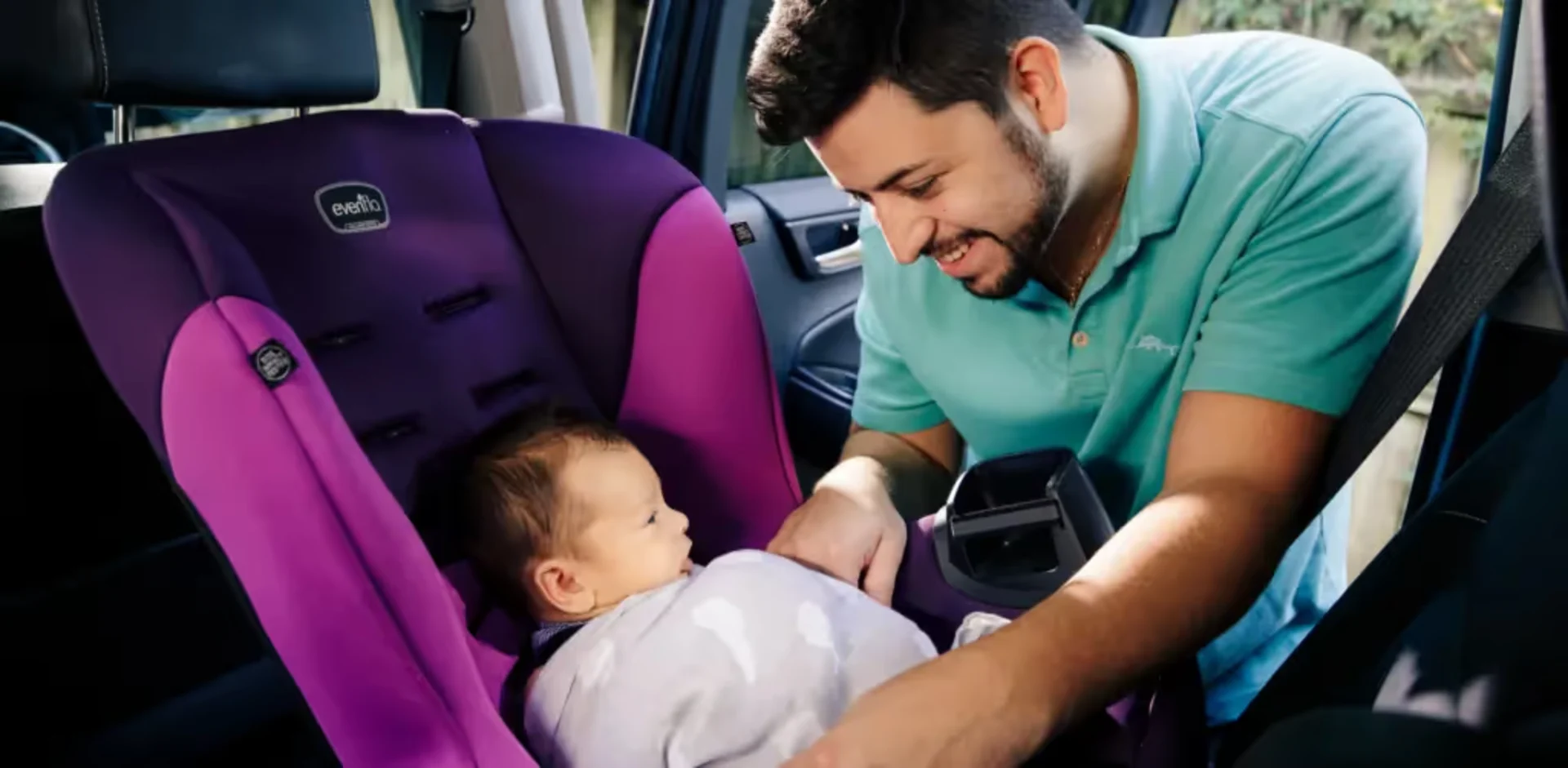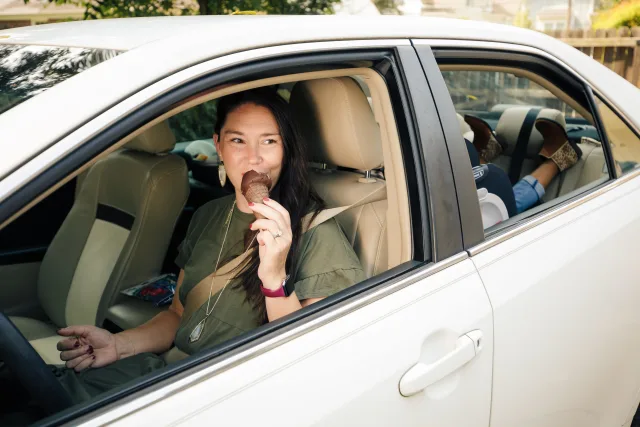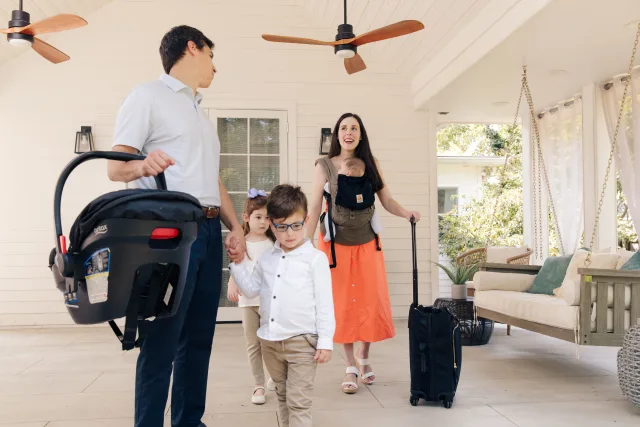In that first week of life, your newborn experiences a LOT of firsts. Your baby’s first car ride home is one of those big milestones in the early days, and this drive home from the hospital takes a lot of preparation. It needs to be both safe and comfortable for baby!
Does the hospital give you a car seat? Will nurses help buckle newborn into car seat? NOPE! Most medical professionals are not trained in car seat safety, which is why 95% of newborns leave the hospital in an unsafe car seat due to installation or buckling errors. (source: Journal of Pediatrics) This means you can’t rely on the hospital staff to confirm your child’s safety in the car, no matter how amazing they are.
It’s your responsibility to find car seat professionals, educate yourself, and prepare for baby’s first car ride (and many more after that!) So, to help you plan for this big milestone, we’ve developed a checklist! Here’s how to keep your baby safe on that first car ride home:
Baby’s First Car Ride Home
Pick the right car seat.
There are lots of car seats out there to choose from. Your lifestyle, budget, and goals all influence what car seat is best for you, so purchasing a seat shouldn’t be taken lightly. We have a handy Car Seat Finder Tool to make the process easier for you! This will make sure you get the seat that fits you, your car, and your baby best.
On a basic level, you need a rear-facing car seat. Both infant car seats and convertible car seats have rear-facing options, so either will work. Many parents prefer the infant car seat option for the newborn stage because the seat detaches and it’s designed for tiny newborns. You’ll be able to get a good fit, and you’ll have the convenience of carrying your seat around! But do some research and pick what’s best for you.
Install your car seat.
Once you have your seat, it’s time to install. Seat installation can be one of the most stressful parts of the car seat journey.
A poorly installed seat will compromise your child’s safety, so make sure you follow the directions in the manual closely and follow our safe install checklist.
In this sample lesson from our Infant Course, you will learn the different types of installation methods for your infant car seat. Whether you are starting your journey on Team Base or Team No-base, in this lesson you’ll learn about all the possible infant car seat installation methods and how to connect your car seat to a vehicle. Want to learn how to keep your child safe on every ride? Check out our Infant Course on the how-tos of installation, harnessing, and troubleshooting.
Meet first-time parents, Jamie and Mike, who are just weeks away from the arrival of their little one. They used our Car Seat Finder Tool to find the best car seat for their newborn. An important part of prepping for the baby is to get the infant seat installed AND practice before the big day. Watch as I put them to the installation test, teach them proper harnessing, and help them make critical adjustments to the car seat for infants to keep their baby safe from the first ride.
Get your car seat checked by a car seat technician.
Even if you follow all the instructions on installation carefully, you could still miss a vital piece of information. Manuals can’t contain all the information there is out there, so finding a child passenger safety technician (who is an expert in car seats) is important.
They can check the seat installation and teach you how to properly strap your child into their car seat. With a car seat consultant, you can have 100% confidence your seat is safe! We offer consults on our website, so you can learn all this from the comfort of your home! (Or, you know, driveway.)
Take car seat safety courses.
Again, there is more to car seats than meets the eye. The scary part is you just don’t know what you don’t know! And, even if the car seat consultant gives you a lot of information, it might be specific to the newborn stage.
But when do you move out of an infant car seat? What tools are safe to use with car seats? How long should your child be rear-facing? Ah! There are SO many questions. Taking car seat safety courses will give you all the information you need to keep your child safe in the seat. You can reference the material whenever you want, so you’re always in the know, regardless of where your child is on their car seat journey.
Eliminate projectile risks.
Objects inside your car become dangerous projectiles in an accident. Even when you’re driving home from the hospital, you’re at risk of a collision. So, you need to prep your vehicle to be as safe as possible. Sharp or hard objects of all sizes can be deadly if not strapped down or tucked away. Get rid of these items or organize them safely before bringing the baby home!

Practice strapping the baby in the car seat.
Once you have the 411 on all things car seat safety, practice strapping your newborn in safely. Baby may not be here yet, but there’s no reason you can’t grab a teddy bear or doll and try it out! Practice adjusting the straps and bucking your newborn, so there is no stress or confusion when baby is here. And once baby arrives, take the chance to practice the real thing in the hospital before it’s time to leave. This will make things easier when it’s time to head home!
Check our YouTube channel for How to Buckle Your Newborn in a Car Seat, Proper Position of Infant Car Seat Harness for a Newborn, and others!
Make plans if your ride is over 2-hours.
Newborn babies should not spend a lot of time in car seats. Spending more than 2-hours in the car can strain a newborn’s spine and cause airflow restriction. So, if you live a good distance from the hospital, make sure you plan for breaks along the drive. This 2-hour rule should always be followed in car seats, even as your child gets older. Remember to give your car seat kiddos a break every couple of hours.
Bring your car seat to the room. (If you can.)
If you have an infant car seat that can be removed, definitely bring it up to the room with you! This way, when it’s time to strap the baby in, you can take your time and make sure it’s perfect. You won’t be rushing or twisting awkwardly while you heal. Get your newborn ready in the room, and then walk them to the car. (But make sure you don’t lift more than what the doctor orders. Someone else might need to carry the seat!)
Have someone pull the car close to the door.
When it’s time to leave the hospital, send someone out to bring the car close to the hospital doors. This is especially important if it’s really hot, cold, or stormy outside. But, really, it’s always a good idea. You shouldn’t be walking too far directly after birth!
Warm/cool the car to room temperature.
Newborn babies’ internal temperature can change quickly in hot or cold environments. Not only could this make them uncomfortable and fussy on the way home, but it could also be dangerous. Heat or cool the car to a comfortable temperature before putting your child inside. Now, when you take baby home they’ll be safe and comfortable!
Double-check buckles and straps.
Before you shut that back door, double-check the buckles and straps. That chest clip should be at the armpits and the straps should be snug enough to pass the pinch test. The straps should come from below the child’s shoulders and nothing should be twisted. Double-check to make sure your child is secure!
Follow traffic laws and limit distractions.
Inform whoever drives home that they need to follow the traffic laws and stay distraction-free. This should go for every drive, obviously, but we all know people tend to speed, mess with the radio, and even text. Distracted driving is incredibly dangerous, so ensure they stay focused and safe while driving your baby home.
Remove the baby from the car seat right away when you arrive home.
Remember, a baby shouldn’t be in the car seat longer than necessary. If your newborn falls asleep on the way home, don’t let your little one stay snoozing in their infant car seat once you arrive home. Quickly transfer the baby to a flat, firm sleep surface. Whether asleep or not, though, get your newborn out of the car seat as soon as possible.
Prepare for your baby’s first car ride to make it a safe and comfortable experience.
If you’re expecting, congratulations! Anticipating your new family member is both exciting and stressful. We hope this checklist for preparing for your baby’s first car ride will help take some of the anxiety out of this process!
Subscribe to our YouTube Channel and be sure to check out 5 Things to Keep Your Baby Safe before your baby’s first car ride home from the hospital, to ensure they are safe from the start!
Have confidence your child is safe in their seat from their first ride with this article, our car seat safety courses, and our expert car seat consultants! And, check back for new info on our blog every week. Safe in the Seat is your one-stop shop for trusted car seat information and education.
As an Amazon Associate, Safe in the Seat earns from qualifying purchases.






